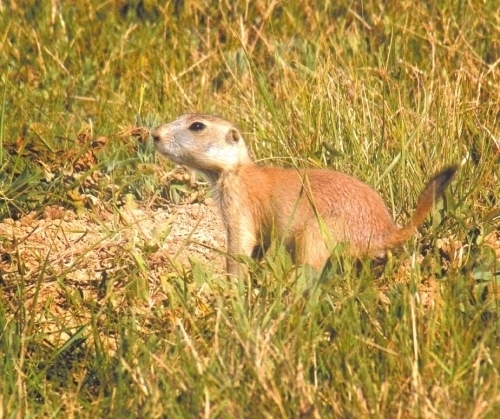
Population estimates over at the Smoky Valley Ranch owned by the Nature Conservancy, for example, are considered to be about half of normal.
"I suppose it's about that way here," said Larry Haverfield, whose ranch south of Russell Springs has the largest concentration of prairie dogs in the area, and, as a result, the largest population of the highly endangered black-footed ferrets.
Haverfield said the first prairie dog pups of the year were spotted May 25, perhaps as many as 20 days later than normal.
Even then, the number of young in a litter appear to be fewer than normal.
Haverfield said he's seen three pups on two burrows. He's only seen one instance where there were four pups in a burrow.
"And everything else, singles or nothing," he said.
Typically, prairie dog litters contain three to five pups.
He suspects reproduction, on the 10,000-acre complex he operates, could be 10 percent to 15 percent of normal.
"Sometimes I go all day long and I don't see a pup," Haverfield said.
That might not bode well for the health of the ferrets, whose reproductive cycle coincides with that of the prairie dog -- offering what has been described as bite-sized morsels for ferrets hoping to feed their young.
The lower reproduction rate was anticipated by Dean Biggins, a wildlife biologist with the U.S. Geological Survey in Fort Collins, Colo.
He was the first to suggest the mysterious disappearance of the prairie dogs last winter might be the result of unusually harsh weather conditions -- in the form of an almost complete lack of rain. He suspected the prairie dogs might have been forced into a hibernation due to what was happening aboveground.
Typically, prairie dogs in Kansas don't hibernate, instead simply going underground for periods of harsh winter conditions.
He also predicted the poor reproduction, speculating the health of the prairie dogs might not be good enough to support it.
The dry weather itself might have caused the lower reproduction because a lack of moisture might have limited the ability to produce milk for the young. Prairie dogs get all of their moisture from the vegetation they eat.
The drought in the last half of 2010, he said, might have simply left them without the energy to reproduce.
"If you have a good year, it should recover fairly quickly," Biggins said of the prairie dog population.
He's unsure what a lower reproduction rate will mean for ferret reproduction given female ferrets are prone to feed on prairie dog pups.
"We might suspect they may have a poor year of reproduction too," he said.
Haverfield suspects the overall prairie dog population on his ranch is slipping as well.
He thinks the population might be half what it was at its peak.
Haverfield said he thinks the ferret population remains strong.
"They've done well, as long as we keep some prairie dogs," he said.



thinks we are talking about Russell Springs in western Kansas